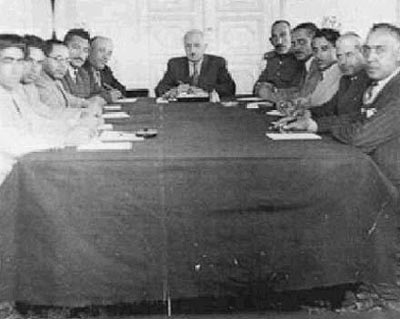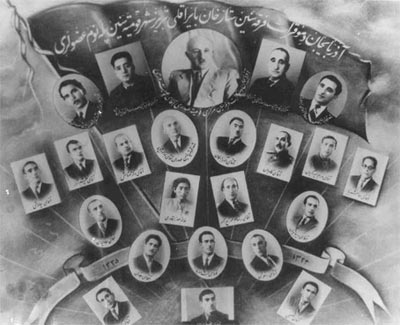Home page
» HISTORY
» States of Azerbaijan
» The Government of the Azerbaijan National Movement-21 Azer
The Government of the Azerbaijan National Movement-21 Azer As it is known, the beginning of the Second World War resulted in enter of Army of the Soviet Union besides Great Britain forces into territory of the country named Iran. This, in turn, led to collapse of the country\'s despotic regime led by Reza Shah. On the one hand, foreign interference, on the other hand collapse of current regime in Iran, caused a creation of some democratic environment. Democratic process was seen in different forms in different regions of the country. The national-liberation movement in South Azerbaijan under the leadership of Seyed Jafar Pishavari resulted in the creation of the National Government.
The National Government of Azerbaijan began activity as government recognizing the right of national autonomy of Azerbaijani Turks in Iran, and then it watched the political direction of the mission to divert into independent statehood.
 With great support of the people of the National Government of Azerbaijan began to implement a number of important jobs. With opening of State University of Tabriz and the large number of secondary schools, the National Theatre and the national Philharmonic, the national libraries, pavement of roads, etc. the National Government could achieve during one year more than Iran government for twenty years.
Douglas William, the American lawyer who visited in 1950 Southern Azerbaijan and compiled a list of changes and reforms made by the National Government and its Prime Minister Seyed Jafar Pishavari, basing on memories of local people of Southern Azerbaijan:
2 . The Government nationalized major banks;
3. Strict laws that prevent officials from receiving a bribe were accepted;
4. Besides cities, mobile hospitals and health clinics providing services in rural areas, were established;
6. Implementation of the social program began, and unemployed people were employed;
7. The National Army of South Azerbaijan was established
The main reforms carried out by the National Government of Azerbaijan during one year can be divided into three categories.
2) Cultural reform;
3) Social and economic reforms.
During the National Government of Azerbaijan fadai groups consisted of voluntary people units, which made a base of the National Army. Fadais, that became during the short period of time as the nation\'s favorite had played an important role in the strengthening of the National Government, strengthening its military power, the trust of people in their state, formation of confidence. Standing of fadai groups before Iran Pahlavi regime, which was much stronger than they, the defense of the national state of Azerbaijan is a unique pattern of high patriotism and heroism.
As a result of serious organizational effort and diligence of Seyed Jafar Pishavari in very short period, the national-democratic forces of Azerbaijan united and laid a foundation of national state relied on support and will of the people.
The second part of the reforms carried out by the National Government of Azerbaijan ensured indeed the implementation of revolution in the country.
The revolution had an aim to act against the policy of assimilation of Pahlavi regime in Iran and to confirm the national identity of Azerbaijan. The process of cultural change based on high treatment of the Azerbaijani language, had began even before November 1945. However, it got the nature of official on January 6, 1946 with “Decision of National Government on Language. This document declared that from today, the official language in Azerbaijan is the Turkish language. So far, the Turkish language was taught in many schools and publication of textbooks in mother tongue had started strongly. Decision making resulted in successful results of this process quickly. In addition, opening of several public institutions like the Art and Painting School of Azerbaijan (January 19, 1946), State Theatre (March 23, 1946), Azerbaijan Radio broadcasting Agency (July 4, 1946) and the State University of Tabriz (June 6, 1946) was the most important events of this process. Since September 1946, since beginning of new academic year, all lessons in school should be taught in the main language Azerbaijani Turkish and successful implementation of this case has one of the important places in reforms in the government in the cultural sphere.
A big revival took place in Tabriz cultural sphere thanks to the activities of writers, poets, literary critics and publicists of Azerbaijan like Southern parts of the structure of the Soviet military, which left the - Suleyman Rahimov, Suleyman Rustam, Mammad Rahim, Osman Sarivelli, Avaz Sadiq, Jafar Khandan, Abbas Zamanov, Gulam Mammadli, Israfil Nazarli and etc went to South Azerbaijan together with Soviet Army troops.
One of the important reforms carried out of by the national government was the formation of media in mother tongue. During 1945-1946 different media organs, newspapers, magazines and journals were published in the South Azerbaijan, including For the sake of Motherland, Azerbaijan, Faryad (cry for help), Azad millat (free nation), Qalaba (Victory(, Yeni Sharq (New East), Maarif (Education), Democrat, Falahət (Tabriz),Jovdat(Ardabil), Urmiyya,Red Soldier (Urmiya),Motherland (Miyana) and country\'s socio-political and literary-cultural life was reflected in them.
The National Government began a number of serious reforms to carry out social and economic changes. The distribution of land to peasants, opening of hospitals in cities and rural areas, pavement of roads, agricultural development, the elimination of unemployment, etc. were among important steps.
Finally, at time of rapid implementation of the socio-economic reforms the national government was declined by Iran Persian regime in December 12, 1946.
It should be noted that, little bit earlier the central government of Iran had officially recognized the autonomous government with agreements signed between them but the same year the Army of Pahlavi Persian State attacked the national government and put an end to its existence. After the occupation of Azerbaijan many Azerbaijani Turks were killed or sent to exile.
The founders of the National Government headed by Seyed Jafar Pishavari have been subjected to great torture. S.J.Pishavari died in July 11, 1947 in suspicious car accident near the town of Yevlakh. Prosecutor General of the Government Firudin Ibrahimi had been executed in Tabriz, Education Minister Mohammad Biriya was imprisoned for more than 22 years by the Soviet political regime. Other founders of the National Government were also arrested and sent to exile and were forced to live the life of emigrants. However, their struggle for freedom and independence of the Azerbaijan was written in the history with their names.
Although the life of the National Government of Azerbaijan was not so long, the creation of this government and its activity gave a push to the next stage of development of the national-liberation movement in the south of the country. Today, the ideological source of liberation movement either in the South or in the different countries of the world is the National Government of Azerbaijan established under the leadership of Seyd Jafar Pishavari.
|
